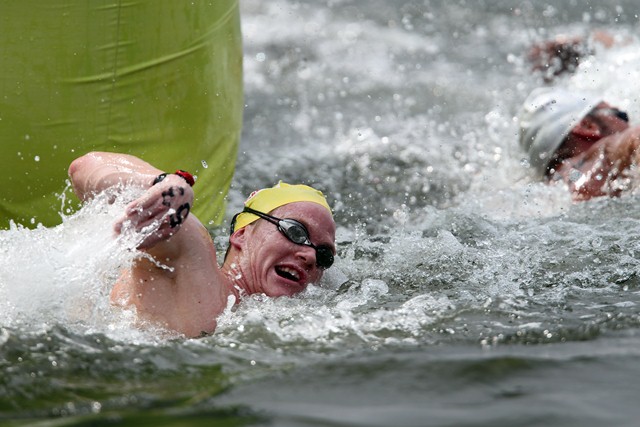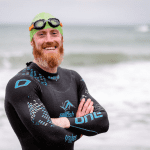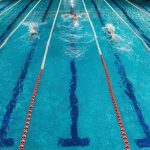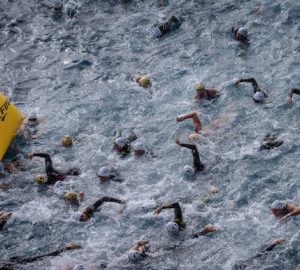
What makes Australian open water swimmers so strong?
Rhys Mainstone tells us about Australian swimming, his training, ambitions and desire to grow open water swimming from a grass-roots level.
This week we’ve received at least two emails from Australia informing us that summer has officially begun and the open water season is getting underway. Australian open water swimming looks strong at all levels, boasts a long list of world class swimmers and has great events ranging from the mass participation Lorne Pier to Pub and the more selective 20km Rottnest Channel Swim. Despite a (relatively) poor showing in the Olympics in the pool and only finishing 20th in the men’s and 11th in the women’s open water, Australian swimmers are still among the best in the world. English Channel record holder Australian Trent Grimsey has already posted a winning performance in New Zealand’s Ocean Swim Series, as has Ky Hurst, Australia’s representative in the Olympic 10km swim. Meanwhile, another Australian, Rhys Mainstone, has been making a name for himself in the sport by winning the Hong Kong leg of the FINA 10km World Cup race (where he beat Olympic silver medallist Thomas Lurz) and following that up with a 4th place in Shantou. Rhys also won this year’s Australian Open Water Championships.
We managed to catch up with Rhys, and asked how Australia produces so many strong open water swimmers. He thinks it all to do with lifestyle and how they grow up.
“Most of the population live close to the sea and so kids learn to swim from a very young age. Australians tend to swim a lot as we’re growing up, say at a friend’s pool or hanging out at the beach with your mates. It’s just a way of life I’d say. As history shows, Australians have always had a great distance swimming background so fellow swimmers want to keep the tradition going of being strong in the open water.”
Rhys himself has been notching up successes in open water since 2009 where he claimed silver in the 10km Open Water, Junior Pan Pacs, in Guam. He says he’s attracted to the sport “as there are so many variables which you need to include to have a good race. You never know what conditions you could get from currents, tides, wind, swell, fresh water to salt water and competitors.”

These successes have been hard earned as while the sport of open water swimming has always been tough its introduction to the Olympics has made it more difficult to reach the top. “It has become so much more competitive and harder to get a great result since it was inducted into the Olympic programme in 2008,” says Rhys.
Still, the possibility of Olympic glory certainly spurs Rhys on. He says, “I made to move from pool swimming in 2006 and took open water much more seriously because of the Olympics and with the aim of an Olympic birth. I made the national team in 2009 and saw what an international elite swim was like and my drive and passion has grown from there.”
He will have his work cut out. It looks like a lot of strong Australian swimmers will be after those coveted slots in Rio, but if he makes the team he can be pretty confident he’ll be one of the best in the world. To be there he will need to maintain a training programme that includes 10 pool sessions per week (over which he averages 80-90km), two main gym sessions, four other land training workouts, physiotherapy, massage, yoga and Pilates. And all of this has to be fitted around his full time job.
Compared to many other swimmers, Rhys, at 177cm, is relatively short (Oussama Melloulie (2012 Gold Medallist) is 192cm, Thomas Lurz and Ky Hurst are both 183cm) but he doesn’t see this as a hindrance, and says height may be less of an advantage outside the confines and flat water of the pool. “I think there are so many different variables which people would need to include before height is a factor in open water swimming. Yes, at an elite level swimmers are a little taller and I noticed that both Olympic golds went to taller swimmers but I think the courses were in a controlled environment (i.e. calm conditions) so the factor of height came into play again.
While Rio is one of Rhys primary goals it’s not the only one. Interestingly, as well as competition goals (such as becoming 10km world champion or winning the FINA World Cup Series) he’d like to be seen as an ambassador for open water swimming. “I’d like to help grow the sport from a grass-roots level with kids, to help them understand the ocean and how much they can enjoy the beach and the sea.”
What about the English Channel? Could he see himself beating Trent Grimsey’s record?
“With Trent being only the second person to go under seven hours I think his record will stand for a long time, unless he breaks it himself. For me, swimming The Channel is something I’d like to do, but late in my swimming career.”
Finally, we asked Rhys where his favourite place in world to swim was.
“I’ve swum in some fantastic places but my favourite would have to be the Maui Channel in Hawaii. The location is perfect and made me appreciate traveling around the world and being able to swim in great places. But it’s not just the places. I like to be with all the swimmers at the events just enjoying each other’s company. It’s a really friendly environment.
On 20 January 2013 Rhys will be competing in the 10km distance of the BHP Billiton Aquatic Super Series which will feature a number of open water swim challenges in Perth’s iconic Swan River. The event is also open to masters and recreational swimmers who can choose from distances ranging from 500m to 5km. A total of $100,000 in prize money over five age and open categories for men and women is up for grabs.
See www.aquaticsuperseries.com.au for details.






